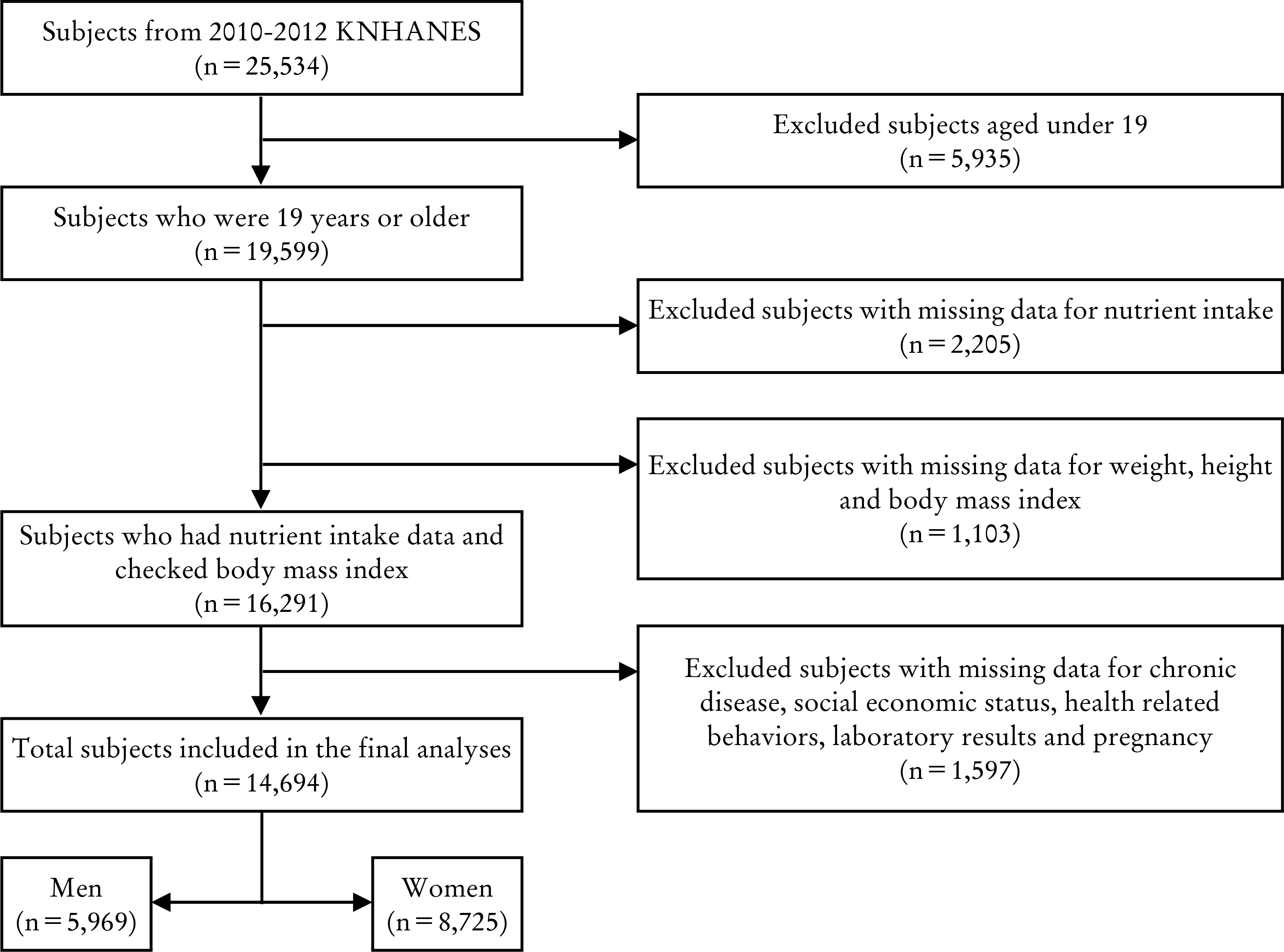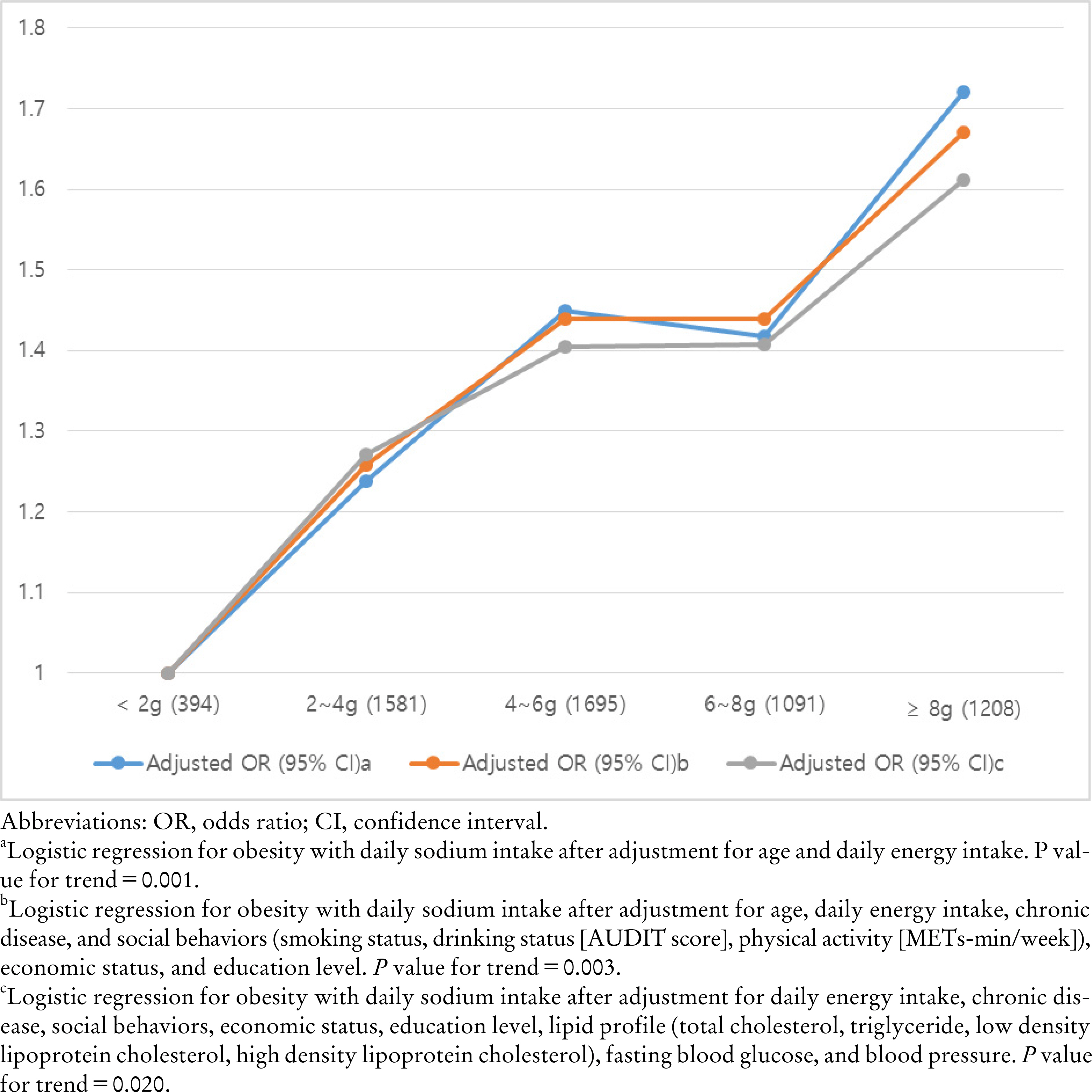References
1. Ministry of Health and Welfare. The National Health Plan 2020 Korea: Ministry of Health and Welfare; 2011.
2. National Institutes of Health Consensus Development Panel on the Health Implications of Obesity. Health implications of obesity: National Institutes of Health consensus development conference statement. Ann Intern Med 1985;103(6 Part 2):1073–7.
4. Hubert HB, Feinleib M, McNamara PM, Castelli WP. Obesity ac an independent risk factor for cardiovascular disease: A 26-year follow up of participants in the Framingham Heart Study. Circulation 1983;67(5):968–77.
5. McInnis KJ, Franklin BA, Rippe JM. Counseling for Physical Activity in Overweight and Obese Patients. Am Fam Physician 2003;67(6):1249–56.
6. Lau DC, Douketis JD, Morrison KM, Hramiak IM, Sharma AM, Ur E. Obesity Canada Clinical Practice Guidelines Expert Panel. 2006 Canadian clinical practice guidelines on the management and prevention of obesity in adults and children. CMAJ 2007;176(8):S1–13.
7. Lenz M, Richter T, Mühlhauser I. The morbidity and mortality associated with overweight and obesity in adulthood: a systematic review. Dtsch Arztebl Int 2009;106(40):641–8.
8. Guh DP, Zhang W, Bansback N, Amarsi Z, Birmingham CL, Anis AH. The incidence of co-morbidities related to obesity and overweight: a systematic review and meta-analysis. BMC Public Health 2009;9:88.
9. Tsigos C, Hainer V, Basdevant A, Finer N, Fried M, Mathus-Vliegen E, et al. Management of obesity in adults: European clinical practice guidelines. Obes Facts 2008;1(2):106–16.
10. Strazzullo P, D'Elia L, Cairella G, Garbagnati F, Cappuccio FP, Scalfi L. Excess body weight and incidence of stroke: meta-analysis of prospective studies with 2 million participants. Stroke 2010;41(5):e418–26.
11. Oh SW, Yoon YS, Shin SA. Effects of excess weight on cancer incidences depending on cancer sites and histologic findings among men: Korea National Health Insurance Corporation Study. J Clin Oncol 2005;23(21):4742–54.
12. Navia B, Aparicio A, Perea JM, Pérez-Farinós N, Villar-Villalba C, Labrado E, et al. Sodium intake may promote weight gain; results of the FANPE study in a representative sample of the adult Spanish population. Nutr Hosp 2014;29(6):1283–9.
13. Libuda L, Kersting M, Alexy U. Consumption of dietary salt measured by urinary sodium excretion and its association with body weight status in healthy children and adolescents. Public Health Nutr 2012;15(3):433–41.
14. Yoon YS, Oh SW. Sodium density and obesity; the Korea National Health and Nutrition Examination Survey 2007-2010. Eur J Clin Nutr 2013;67(2):141–6.
15. Song HJ, Cho YG, Lee HJ. Dietary sodium intake and prevalence of overweight in adults. Metabolism 2013;62(5):703–8.
16. Larsen SC, Ängquist L, Sørensen TI, Heitmann BL. 24h urinary sodium excretion and subsequent change in weight, waist circumference and body composition. PLoS One 2013;8(7):e69689.
17. Ministry for Health, Welfare and Family Affairs; Korea Centers for Disease Control and Prevention. National Health Nutrition Examination Survey Report Cheongwon: Korea Centers for Disease Control and Prevention; 2013.
18. WHO. Guideline: Sodium intake for adults and children Geneva: World Health Organization; 2012.
19. Babor TF, Higgins-Biddle JC, Saunders JB, Monteiro MG. AUDIT - The Alcohol Use Disorders Identification Test: Guidelines for Use in Primary Care 2nd ed.th ed. Geneva: World Health Organization; 2001.
20. International Physical Activity Questionnaire. Guidelines for data processing and analysis of the International Physical Activity Questionnaire (IPAQ). International Physical Activity Questionnaire 2005. [Accessed March 2, 2012].
http://www.ipaq.ki.se.
21. WHO/IASO/IOTF. The Asia-Pacific perspective: redefining obesity and its treatment Health communications Australia: Melbourne; 2000.
22. Yon M, Lee Y, Kim D, Lee J, Koh E, Nam E, et al. Major sources of sodium intake of the Korean population at prepared dish level-based on the KNHANES 2008 & 2009. Korean J Community Nutr 2011;16(4):473–87.
23. Hoffmann IS, Cubeddu LX. Salt and the metabolic syndrome. Nutr Metab Cardiovasc Dis 2009;19(2):123–8.
24. Deglaire A, Méjean C, Castetbon K, Kesse-Guyot E, Hercberg S, Schlich P. Associations between weight status and liking scores for sweet, salt and fat according to the gender in adults (The Nutrinet-Santé study). Eur J Clin Nutr 2015;69(1):40–6.
25. Gibson S, Neate D. Sugar intake, soft drink consumption and body weight among British children: further analysis of National Diet and Nutrition Survey data with adjustment for under-reporting and physical activity. Int J Food Sci Nutr 2007;58(6):445–60.
26. He FJ, Marrero NM, MacGregor GA. Salt intake is related to soft drink consumption in children and adolescents: a link to obesity? Hypertension 2008;51(3):629–34.
27. Fonseca-Alaniz MH, Brito LC, Borges-Silva CN, Takada J, Andreotti S, Lima FB. High dietary sodium intake increases white adipose tissue mass and plasma leptin in rats. Obesity (Silver Spring) 2007;15(9):2200–8.
28. Fonseca-Alaniz MH, Takada J, Andreotti S, de Campos TB, Campaña AB, Borges-Silva CN, et al. High sodium intake enhances insulin-stimulated glucose uptake in rat epididymal adipose tissue. Obesity (Silver Spring) 2008;16(6):1186–92.
29. Nunez MF, Mollard RC, Luhovyy BL, Wong CL, Anderson GH. Acute sodium ingestion has no effect on short-term food and water intake, subjective appetite, thirst, or glycemic response in healthy young men. Appl Physiol Nutr Metab 2013;38(7):746–52.
30. Dalmasso C, Amigone JL, Vivas L. Serotonergic system involvement in the inhibitory action of estrogen on induced sodium appetite in female rats. Physiol Behav 2011;104(3):398–407.





